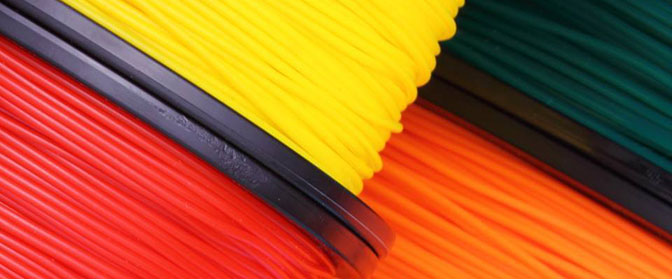5 Most Popular 3D Printing Thermoplastics
As 3D printing becomes more popular, and the price of printing machines plummets from the prices of only a few years ago, so the price of feedstock also drops and at a time when the range of printing materials increases. It is now possible to print using a number of common thermoplastic materials that can be melted and reformed as necessary to form complex shapes.
One of the most common methods of low cost desk-top printing is the Fused Filament Fabrication (FFF) process. This method uses a thin filament of fusable thermoplastic to build up a product in layers. Each layer of the hot material welds onto the previously laid down and gradually produces the whole part. This is an incredibly simple process and one that can make parts of high durability and complex shape. There are several notable thermoplastics that can be used with this process, producing a variety of results depending upon their base properties. The main materials currently used are;
Polylactic Acid (PLA). This versatile and relatively low cost printing material that is readily available and can be used for many articles. It’s not the strongest of the printing polymers available but is extremely useful depending upon your application. It is derived from corn starch and is therefore biodegradable over time. PLA shapes find great use as removable shape used in modern investment casting processes. The finished, printed shape is coated in a ceramic film before being burnt out and the resulting void filled with molten metal to form the proper part.
Don’t Miss: Best PLA Filaments
Acrylonitrile Butadiene Styrene (ABS). This is a tough material that can be used to create finished parts that will put up with the rigours of everyday use. Slightly problematic if the feedstock is kept in a humid area, ABS works best when thoroughly dry. As with all thermoplastics, filaments are available in a range of colours.
Don’t Miss: Best ABS Filaments
PolyAmide (PA). More usually known under its trade name of Nylon, this is a hardwearing and easy to use material that can be used to manufacture complex yet high strength components. This is a relatively cheap material though its affinity to moisture surpasses even ABS so correct storage is essential when considering using Nylon.
High Impact Polystyrene (HIPS). This is s a tough durable material akin to ABS though not the cheapest option. HIPS uses Limonene as a solvent which tends to make the finished part smell slightly of lemons, but that’s not all bad is it. The heater element of the printer needs to be controlled quite finely with this material otherwise there will be a fair degree of warping as the hot material is placed on the cooling layer, but with smaller parts (which you’ll probably want to do anyway since it’s an expensive base material) the speed of printing should be just fine to prevent warpage.
Thermoplastic Elastomer (TPE). This is an exciting new innovation which allows the printing of a soft, elastomer material, similar to soft rubber. This makes components that can have a slight stretch and give as needed rather than the ridged parts mad from other materials. With even the cheapest 3D printers being capable of producing multi-layup components, the stage is set to produce hard articles, such as shows, that have a soft and fielding internal area.
This is by no means an exhaustive list of materials that can be used with common 3D printers, but they will be able to fulfil your most outrageous designs.
Read more here if you are looking to buy 3D printing filament and you want to know the best brands.





Many Thanks for sharing this article!
(Quality filaments,liquid photopolymers for 3D printers )